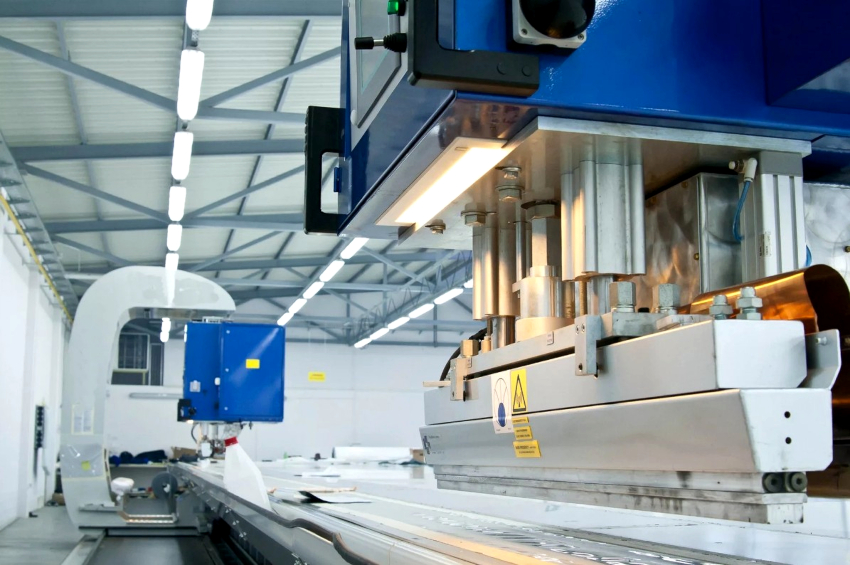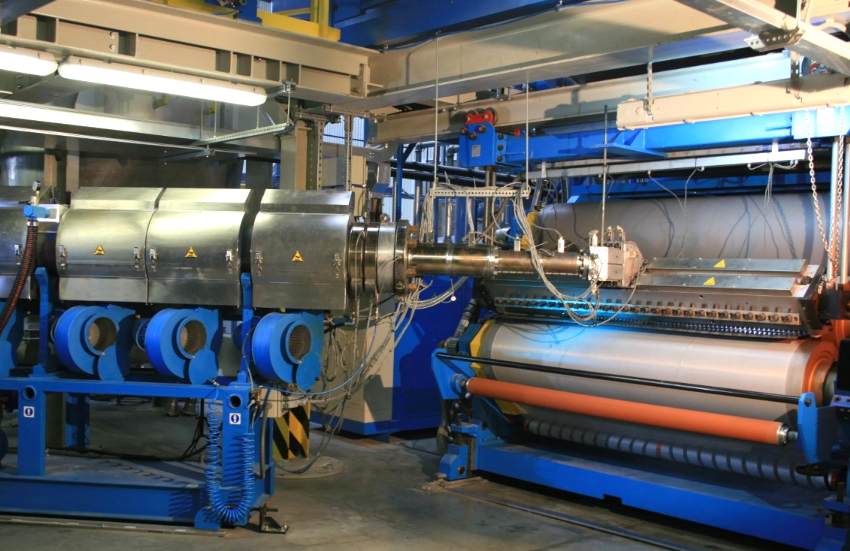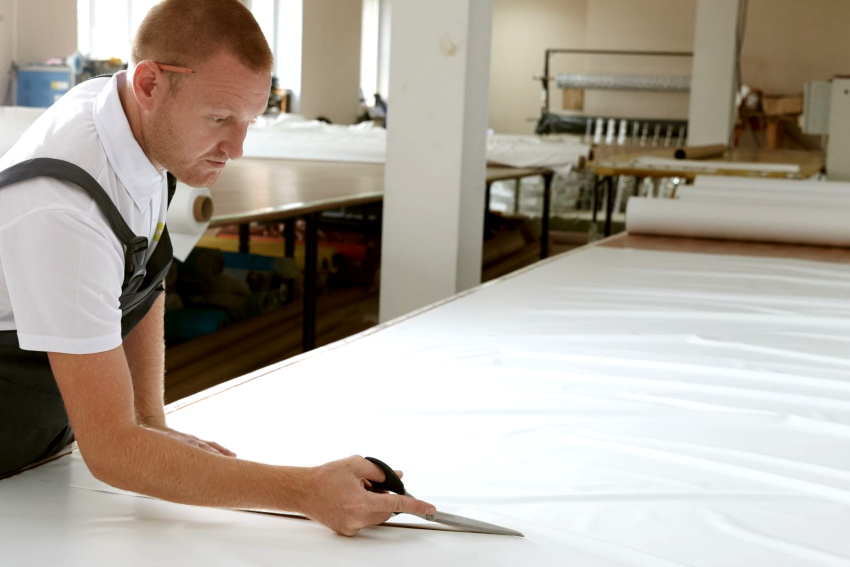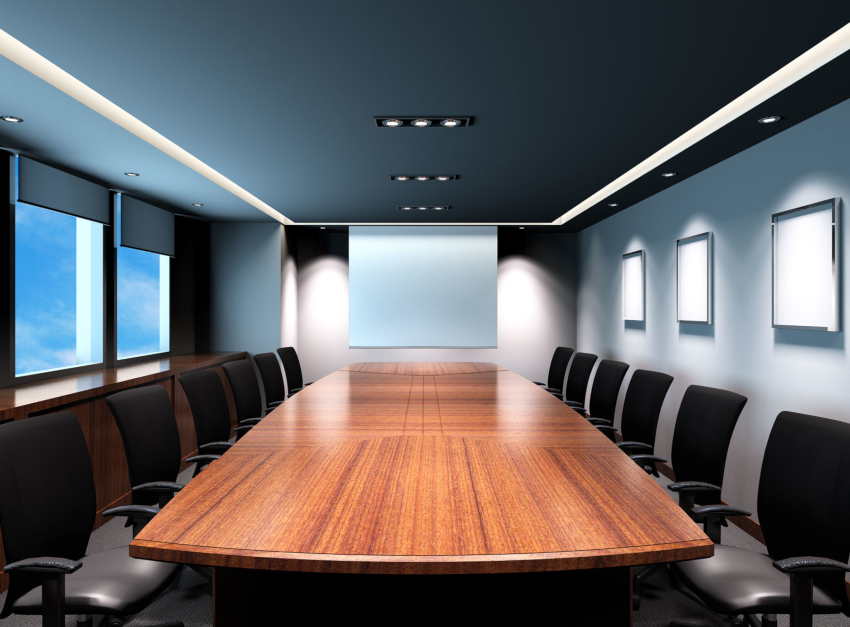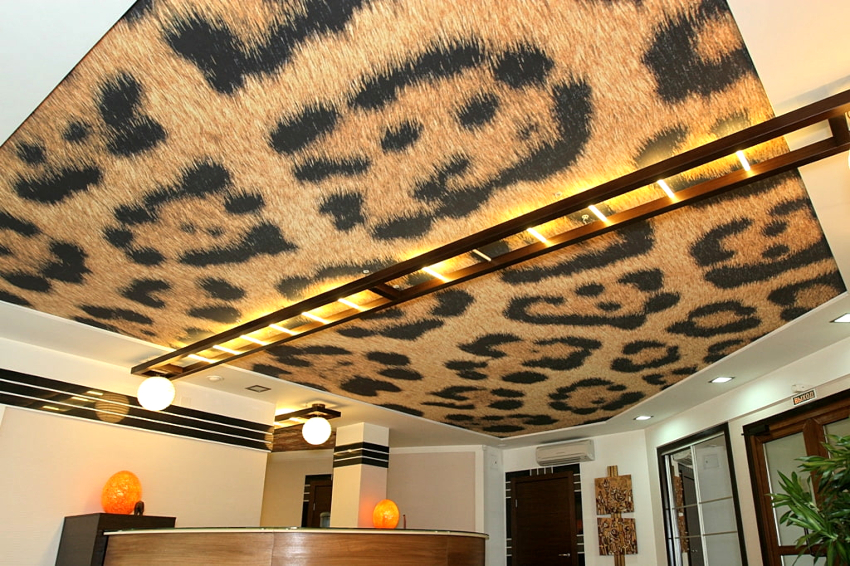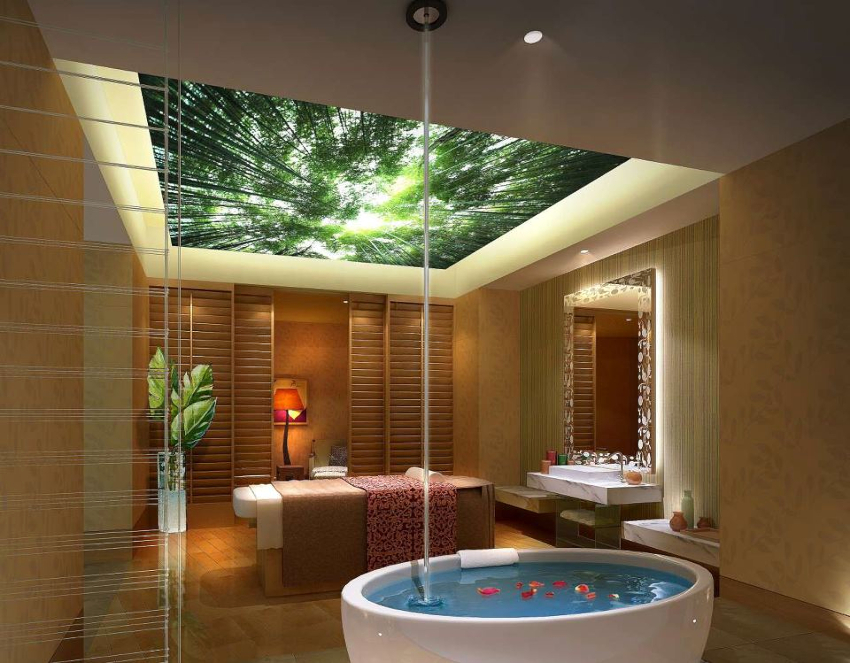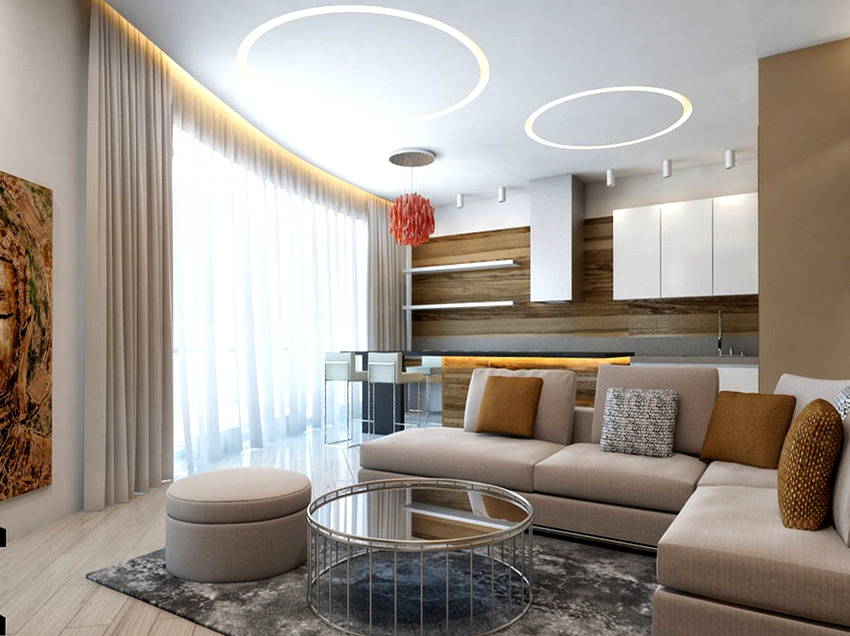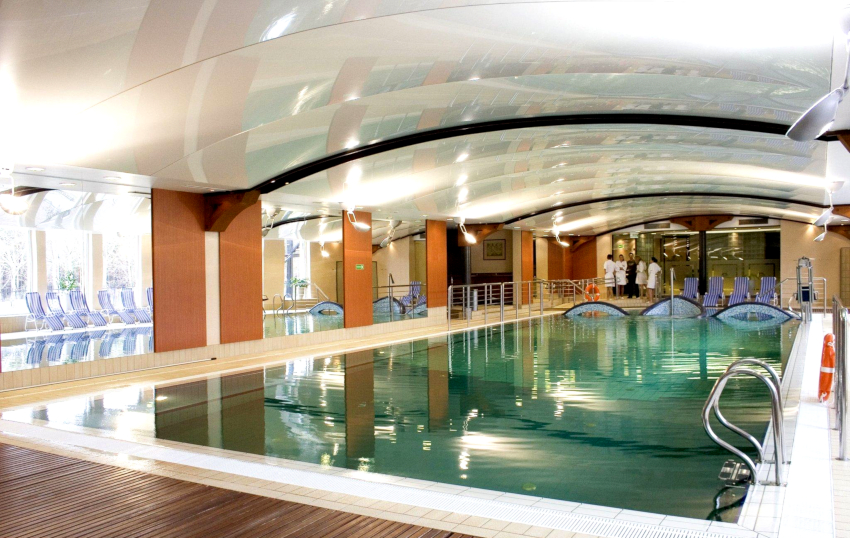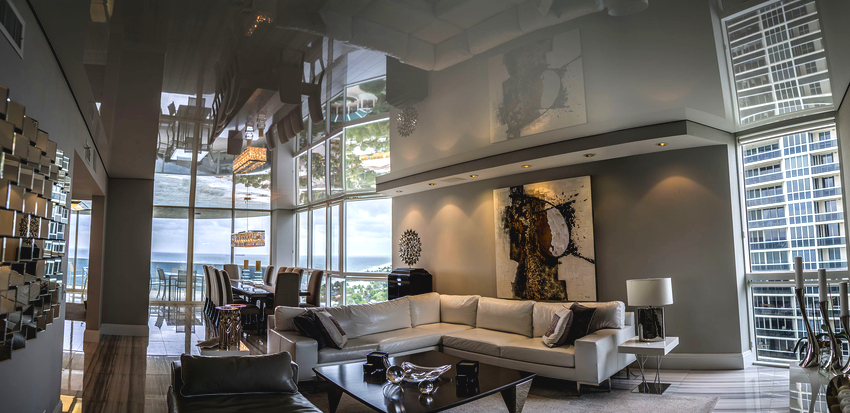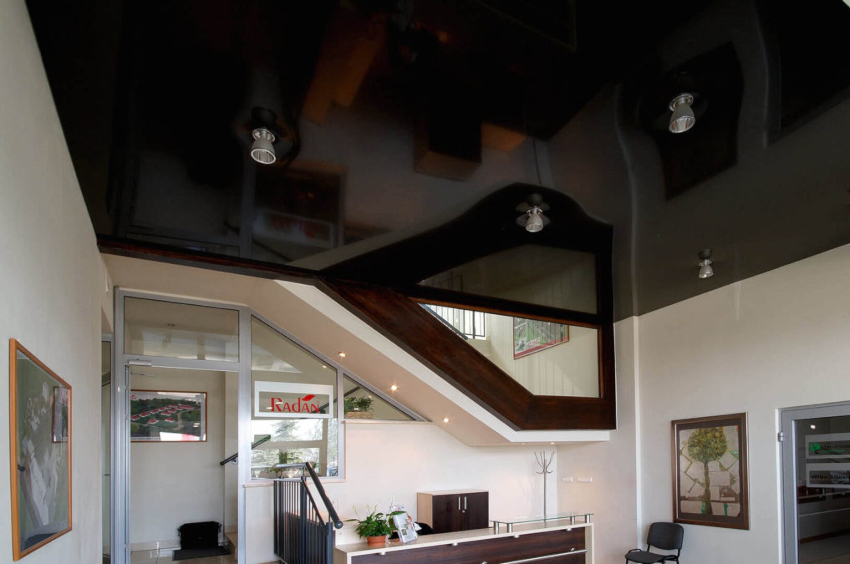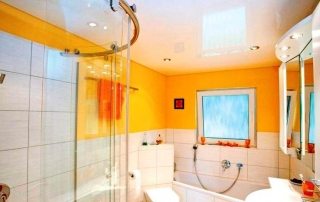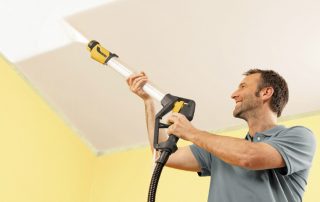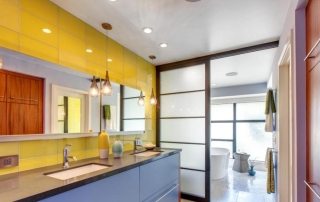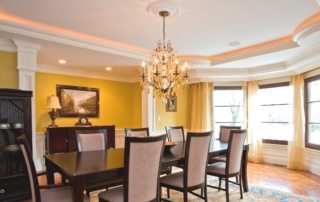When carrying out repairs, I want to create an attractive room and at the same time not stretch the terms of the work. Numerous types of stretch ceilings will help you choose the optimal design of the canvas, which will be an excellent addition to any interior. Matte, glossy, fabric and satin textures, which can be given almost any shape, do not lose their original appearance for a long time and are mounted within a maximum of a day.

Due to the diversity stretch ceilings, you can choose the optimal design of the canvas for any interior
Content [Hide]
- 1 What are stretch ceilings and how are they made: stages of production
- 2 The main types of stretch ceilings: the pros and cons of structures
- 3 The most popular types of stretch ceilings: material characteristics
- 4 What are the types of stretch ceilings by structure and shape
- 5 How to choose the colors of stretch ceilings, the values of the main shades
What are stretch ceilings and how are they made: stages of production
Almost everyone knows that stretch ceilings look like a highly stretched canvas that covers the entire surface, and is fixed using a special profile made of plastic or aluminum. Most often, in the manufacture of canvases, PVC film or high quality synthetic textiles are used. Basically, for this purpose, polyester impregnated with polyurethane is used, which gives the fabric a high density.
If you are interested in finding out what the production process looks like, you can find videos and photos available on the network in which the manufacturing stage is shown without unnecessary details, because each manufacturer has its own secret technologies that help improve the quality of finished products. In any case, the process is not as simple as it might seem. In general, the production of PVC film consists of the following stages:
- The container is filled with polyvinyl chloride granules mixed with UV and heat stabilizers.
- Pigments, additives and various plasticizers are mixed into the mixture, after which they begin to heat up.
- Heating continues until a homogeneous plastic mass is formed.
To make a PVC film, designed to create a canvas, the mass is rolled out on special equipment. It is this moment that requires the greatest investment, because calendering machines are distinguished by their high cost. The tool itself is a rolling machine consisting of a system of roll pairs.On the first pair, the web is given the required width and thickness, the subsequent ones create good consumer qualities of the film. Below is the video "How stretch ceilings are made".
Important! You should only buy products from manufacturers that specialize in the production of canvases. In this case, there is a guarantee that all tools are used only for the manufacture of film, which is durable and of high quality.
How stretch ceilings are made and what is their feature
As for how stretch ceilings are made in a room, it should be noted that the process consists of the following stages:
- Ceiling parameters are measured, taking into account the shape and characteristics of the room: protrusions, pipes and other elements.
- Using the obtained dimensions, the designer, using special programs, cuts the canvas taking into account the future shrinkage, which on average does not exceed 10%. Shrinkage is necessary so that after fixing the canvas and using the gun, it is possible to make the surface perfectly flat.
- After that, cutting is carried out in the workshop using professional equipment. In order not to accidentally get creases on the canvases after cutting, the film is laid with a special material.
- If one sheet is not enough to close the ceiling, special welding on high-frequency machines is used, which connects the parts without forming seams.
- At the final stage of production, a fastening system is welded along the perimeter of the canvas, most often a harpoon.
Do not confuse the installation of a tension web with the creation of a hinged structure. How to make a false ceiling? First, a frame is mounted, consisting of longitudinal and transverse profiles and suspensions, on which, as a result, the material selected for the false ceiling is attached. The main types of suspended ceilings include plasterboard, lattice, rack and tiled.
Regardless of which stretch ceiling to choose, in any case, it will turn out to give the room a neat and attractive appearance. A combination of a false ceiling and drywall is often used, which plays the role of a framing for a film or fabric. So, with the use of combined ceilings, it is possible to create attractive designs.
To install a stretch ceiling made of a film, a special heat gun is used to heat the material, which can be easily stretched. After that, you need to stretch it and hide it under a pre-assembled baguette. As it cools, the web gradually shrinks and forms a perfectly flat surface.
A large assortment of stretch ceilings is presented on trading floors. The types of materials are very diverse, they differ in color and texture. Thanks to the wide selection, it is possible to create one-of-a-kind ceilings suitable for any interior style:
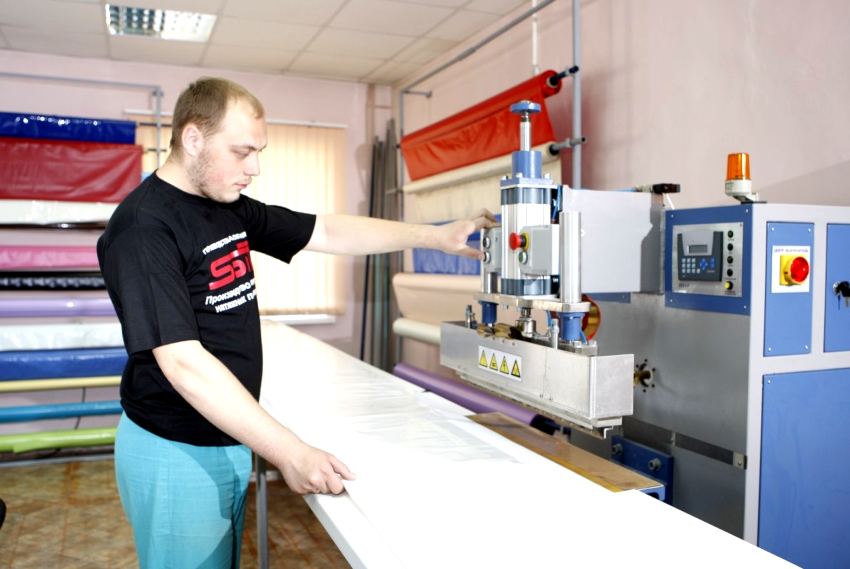
If it is necessary to connect several pieces of canvases, special welding on high-frequency machines is used
- A white ceiling with a matte texture will be an excellent addition to the classic style, because it looks like a neatly leveled and putty surface. There will be no transitions or irregularities on the surface.
- In appearance, satin fabric looks like a neatly painted ceiling, but at the same time it has an attractive color and an unobtrusive shine.
- The glossy version of the mirror effect ceiling is great for low-rise rooms. The reflectiveness of ceilings will help make the room visually larger and more spacious. Therefore, you can often see the use of the film in a cramped "Khrushchev".
The main types of stretch ceilings: the pros and cons of structures
Despite the fact that stretch ceilings appeared quite a long time ago, they still do not lose their relevance. On the contrary, canvases are becoming more and more popular, because they constantly come up with new textures and surfaces, and at the same time the cost becomes affordable for most buyers.
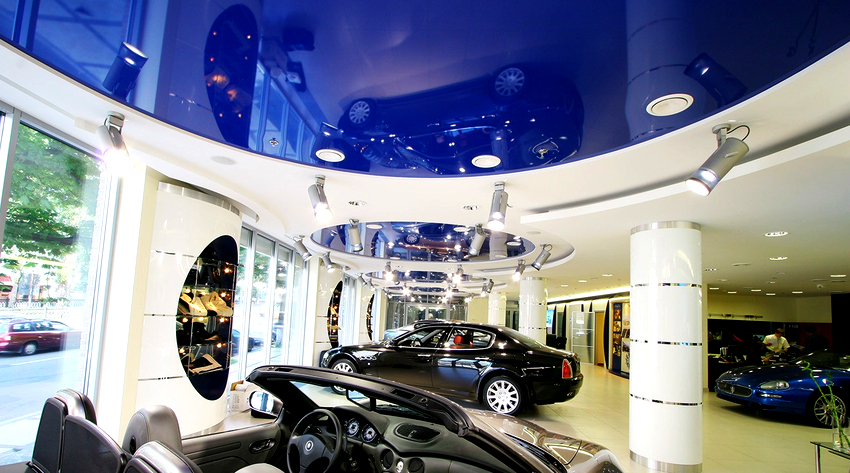
Due to the emergence of new textures and surfaces, as well as the constant cost reduction, stretch ceilings are becoming more and more popular
In the catalogs of stretch ceilings, the photos illustrate that today materials are available for purchase, the surfaces of which imitate velvet, wood, stone or leather surfaces. When choosing non-standard options, you will need to be very careful when buying furniture and accessories, so as not to make the room too heavy and the interior overloaded.
When decorating modern rooms using bold ideas and non-trivial interiors, designers recommend choosing varieties of stretch ceilings with photo printing. Of course, the cost of such an option will be 2-2.5 times more expensive, but a room with an unusual design will convey the personality of the owner and will become one of a kind. Among the drawings, canvases with a starry sky are especially popular, which are installed in bedrooms or children's rooms, and supplemented with diode ribbons and lanterns.
Important! The materials used for stretch ceilings are quite susceptible to high temperatures, which provoke deformation of the canvas. For this reason, it is categorically not recommended to place lanterns near the ceilings, which are very hot when they are on.
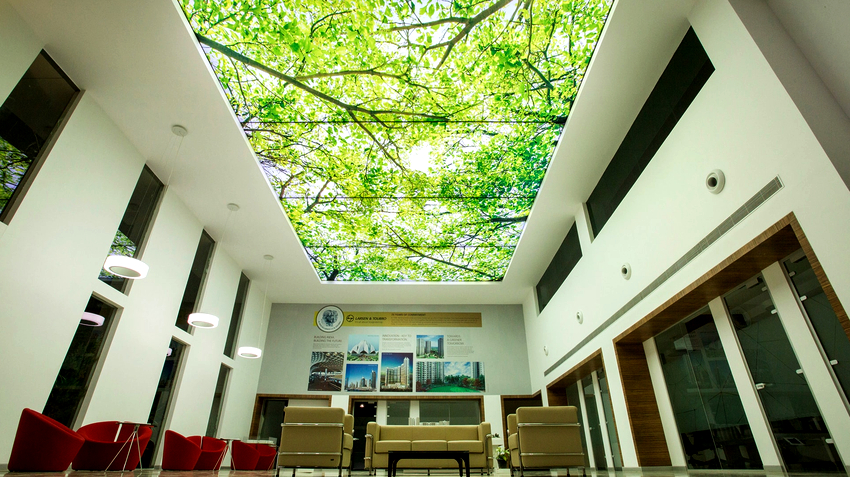
When decorating premises using non-trivial ideas, designers recommend choosing stretch ceilings with photo printing
Like all other finishes, the types of materials used to create a ceiling differ in their advantages and disadvantages. Before giving preference to a stretch fabric, you should familiarize yourself with all the characteristics. One of the main advantages of stretch ceilings is the high installation speed.
Installation of a plasterboard ceiling in some cases takes more than one week, because you need to fix the profile, strengthen the surface with fiberglass, plaster and paint it. In the case of installing a stretch canvas, specialists measure the ceilings and after a few days they bring the finished canvas, which is assembled in one day. At the same time, the installation will not be accompanied by the formation of dust or a large amount of waste.
Other advantages of installing stretch ceilings
The installation of tension structures has many advantages, among which are:
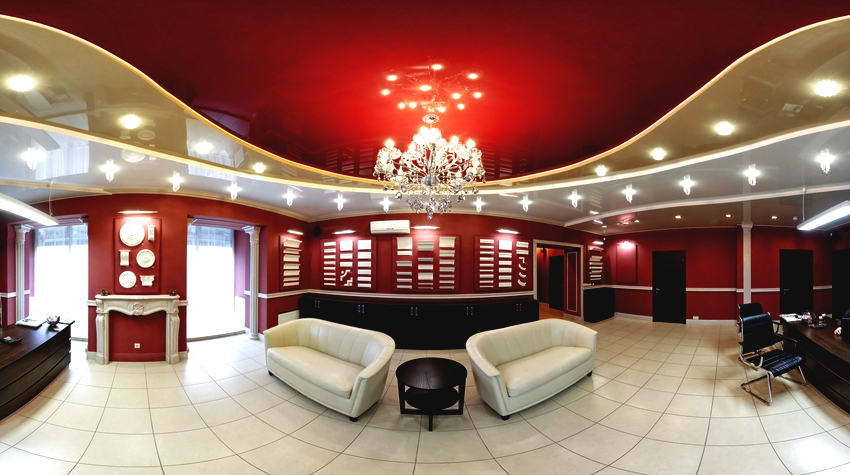
Stretch ceilings have a lot of advantages - they are practicality, elasticity, attractive appearance, reliability and durability
- No need for preliminary work to level the ceiling. This will save you a fair amount of time and money. In addition, you do not have to get rid of the previous coating.
- Practicality. The space between the ceiling and the canvas can be used to aesthetically hide various communications.
- Lack of debris when installing stretch ceilings. Work is not accompanied by the formation of dust, which makes it possible to update the ceiling covering without taking furniture and other items out of the room.
- Attractive appearance. Using high-quality materials, it is easy to achieve perfectly flat surfaces that allow you to hide any nuances on the ceiling.
- Reliability and durability. Well-known European manufacturers give at least a 10-year warranty on their canvases, although buyers claim that the attractive appearance lasts much longer.
- Safety. Previously, many buyers doubted whether stretch ceilings could be used in children's rooms, because they believed that they emit harmful substances.In fact, in the composition of the canvases there are no toxic substances that are distinguished by an unpleasant odor or cause allergies.
- Rich assortment. To choose the material that is ideal for a room, you need to know what kind of stretch ceilings are in color and texture. In general, at present, there are practically no restrictions on the choice, because modern technologies allow you to create more and more new options.
- High moisture resistance and the absence of the likelihood of condensation. This makes stretch ceilings the best option for kitchens, baths, indoor pools and other rooms with high humidity.
- Elasticity. Due to the peculiarity of the materials of the canvases, it is easy to give the ceiling any, even the most bizarre shape.
- Simple operation. Dismantling and installing ceilings does not take much time, and in case of minor damage, they can be restored.
- Flood protection. Due to its elasticity, the canvas is able to protect other surfaces from flooding from above. On the web, you can find videos showing ceilings that sagged under the weight of water, which did not lose their integrity.
- Shrinkage resistance. You can install ceilings in newly built houses and not worry that they will crack or deform during the shrinkage period.
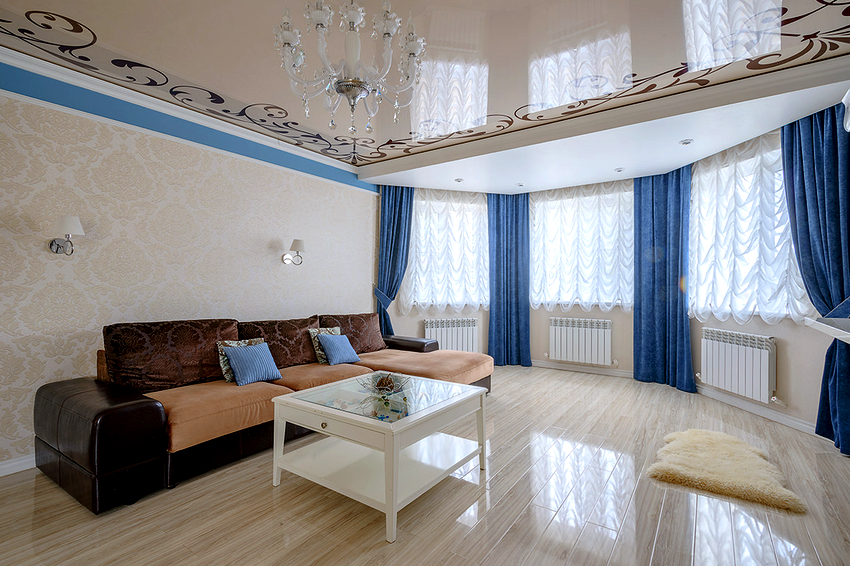
The disadvantage of stretch ceilings is the high probability of damage to the canvas with sharp objects
Among the positive points, one can also note good heat and sound insulation qualities. In addition to the large number of advantages, it is necessary to mention the disadvantages of stretch fabrics, which include the following:
- Potential damage to ceilings with sharp objects. This mainly applies to PVC films, which are fragile and thin.
- The ability to tolerate high or too low temperatures poorly. It is best to operate ceilings at temperatures from +5 to +50 ° C, under other conditions there is a possibility of deformation and loss of elasticity of the canvas.
Some consider the high cost to be a minus, although if you recalculate the cost of making plasterboard ceilings, including the cost of materials and installation, then there is not so much difference.
The most popular types of stretch ceilings: material characteristics
There are fabric and film coatings, and each material has different advantages and parameters. To figure out what types of stretch ceilings are and which of them are the best, you should study the characteristics of each and only then make a deliberate choice.
Related article:
Glossy stretch ceiling: mirror shine and additional volume in the room
The main advantages and disadvantages of the installation. Types of materials and popular color options. How to care for a stretch ceiling.
Fabric ceilings appeared much later than film ceilings. They are widely used. The fabrics are durable due to special polyurethane impregnations for polyester fabrics, which make the material durable and resistant to many external influences, including mechanical ones. These stretch ceilings are usually seamless and consist of a single sheet. Although it is possible to make custom-made canvas of non-standard size, consisting of two or more sheets.
Important! When ordering, it should be borne in mind that a covering consisting of one element will always be cheaper than a ceiling made of several separate sheets. Therefore, if you choose which ceiling is best to make, you should pay attention not only to the design, but also to the standard roll sizes.
Among the main advantages of using a fabric cloth are the following:
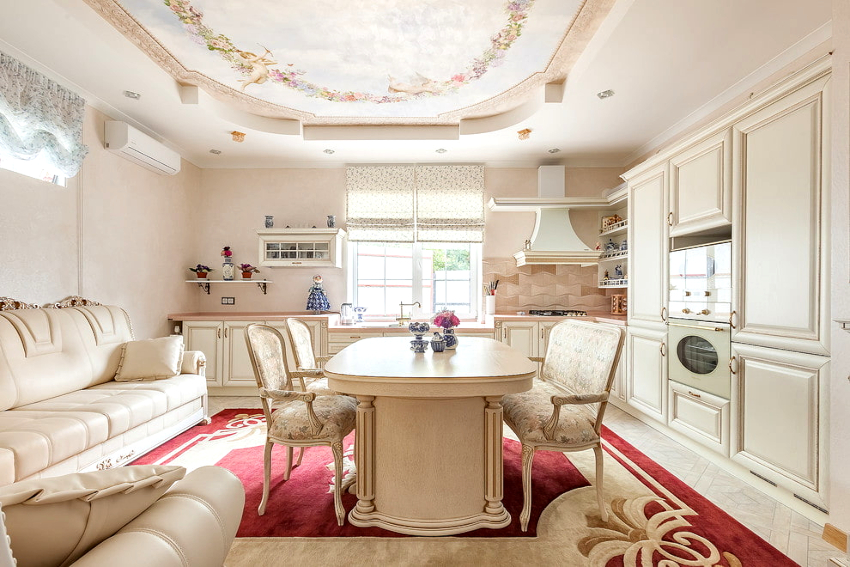
Thanks to special polyurethane impregnations, fabrics are strong, durable and resistant to external influences
- the fabric is much better combined with other materials in the interior;
- the canvas harmoniously fits into the interior design and creates a pleasant indoor climate;
- the compositions used to impregnate fabrics are absolutely harmless to human health;
- the canvas is quite durable and, unlike PVC ceilings, it is very difficult to accidentally damage it with a sharp object;
- the ceilings are easier to install, because no additional equipment is required for their installation;
- if desired, the canvas can be repainted, but it is not recommended to update the color more than 5 times.
Fabric ceilings are "breathable", which allows air to circulate freely between surfaces. This means that there is very little chance of condensation and mold forming on the fabric. This feature significantly increases the service life of the finishing material. The fabric cloth, unlike the film one, can withstand negative temperatures, so it can be used to decorate unheated rooms: balconies, verandas.
If, before repairing a spacious room, you ask yourself what are the sizes of ceilings, then you need to take into account that the fabric is made in rolls up to five meters wide, which allows you to close a large area with one sheet. The material also has disadvantages:
- despite the impregnation of the material, the micropores become clogged with dust over time, so the ceiling requires regular cleaning;
- the fabric absorbs odors and vapors, therefore, ceilings are not recommended to be installed in the kitchen or bathroom;
- textiles will not be able to retain water in an emergency, for example, if the apartment is flooded by the neighbors upstairs;
- stretch fabric ceiling, unlike PVC film, does not have a wide variety of textures;
- prices for textile coating are much higher than for film sheets.
Other types of ceilings: brief characteristics of PVC films
PVC film ceilings are sold in rolls with a width of 1400 to 5600 mm, so this option is considered the best stretch ceiling for a spacious hall or living room. The film itself has a small thickness - about 0.22 mm. Nevertheless, the material is very strong and elastic, which allows it to withstand loads of up to 100 kg per m².
PVC has the following advantages:
- A wide range of colors and the ability to apply photographs and drawings improve the design of any room. It should be borne in mind that drawing a picture will cost at least 2000 rubles. per square.
- The canvases have different surfaces. You can choose glossy, matte or satin stretch ceiling samples that will imitate plaster, painted ceiling or any natural materials.
- A properly installed ceiling can last about 15 years without any problems, which will allow you to forget about repairs for a long time.
- With careful handling, the material does not require special care. It is recommended to simply clean it occasionally with a damp sponge.
- PVC ceilings are absolutely safe for human health and do not emit toxic substances or unpleasant odors during operation.
- Possibility of repair. If the integrity of the canvas is violated, you can not fall into despair, because it is not difficult to glue the stretch ceiling with your own hands after a cut, for this you need a fragment of material, as well as glue.
The disadvantages of PVC-film ceilings include the fact that they cannot be installed in unheated rooms, since they cannot withstand temperatures below 5 degrees. Installation requires the use of a special heat gun, which excludes the possibility of self-installation.
How to choose a PVC film stretch ceiling depending on the texture
Before choosing a stretch ceiling, you should study what types of films there are, because PVC canvases have a different surface texture. Each of them has its own characteristics:
- Matte. The surface often resembles a high quality applied plaster. The canvases are popular because they do not differ in shine and look natural. In addition, the matte ceiling blends well with classic interiors.
- Glossy. Most often, there are types of glossy canvases in the photo of stretch ceilings for the hall, because with their help it is easy to cover a large area and perform zoning. Mirrored ceilings work well for poorly lit rooms.
- Satin. The finish is a cross between matte and glossy finishes. But if a matte surface is like plaster, then satin looks like a painted surface with a dull finish. Very often it is the satin canvas that is used to create combined plasterboard and stretch ceilings.
Helpful advice! If the question is, what is the best way to make the ceiling in the bathroom, then experts in this case advise to choose matte coatings, on which drops are not so visible and which are easier to care for than a glossy or satin surface.
What are the types of stretch ceilings by structure and shape
Thanks to the elasticity of the material, the ceiling can be given any shape, sometimes even the most incredible. Various photos of types of stretch ceilings make it possible to understand that in a room you can not only create simple angular or rectangular surfaces, but also give them a unique appearance. It is worth highlighting the following main types of ceilings:
- Arched. The shape of the vaulted ceiling radically changes the appearance of the room. Usually this option is used in the living room or hall, creating a smooth transition from the ceiling to the wall plane. For example, in this way they depict a starry sky or a sunny day with floating clouds on a blue surface.
- Wavy. Most often this type of stretch ceilings is used for the bedroom (photos are presented below). The wave-like shape of the structures transforms the room in a unique way, creating a feeling of expanding space and beneficially affecting the nervous system, especially if the soothing tones are correctly selected.
- Conical. As a rule, the cone in a stretch ceiling is located in the center of the structure, therefore, a lighting device mounted on a rigid support is usually used to complete the image. At the same time, you can select a lamp of any shape. This option is used more often in living rooms, spacious dining rooms or halls.
- In the form of a bell or a dune. This design will be a great addition to a luxurious interior; it is a hilly surface or a volumetric bell. To create such a non-trivial shape, it is better to choose a glossy canvas that favorably combines glare and reflections, which will add volume to the picture.
What are the stretch ceilings depending on the number of tiers
Different types of ceilings are distinguished depending on the number of levels. The traditional option can be considered flat stretch ceilings, covering the entire surface. This method of decoration will be characterized by perfect smoothness, which will give the room an elegant look. If you choose the right color and select the necessary lighting sources, it will turn out to visually make the room higher. Despite the ease of installation, single-level surfaces look no less impressive than other complex structures.
It is interesting! It should be noted that installing a single-level stretch ceiling is much easier than any other design. Due to the fact that the frame under the canvas is installed at the same level, it does not require complex calculations. For installation, it is enough to break the ceiling with horizontal lines at the desired height.
When performing a multi-level structure, you should first of all understand that this option will take at least 10-15 cm of the height of the room. Therefore, if the ceilings are lower than standard, it is better to refuse such an idea. In general, multi-level structures look attractive and unusual. It is especially good to use this option in spacious rooms where it is necessary to perform space zoning:
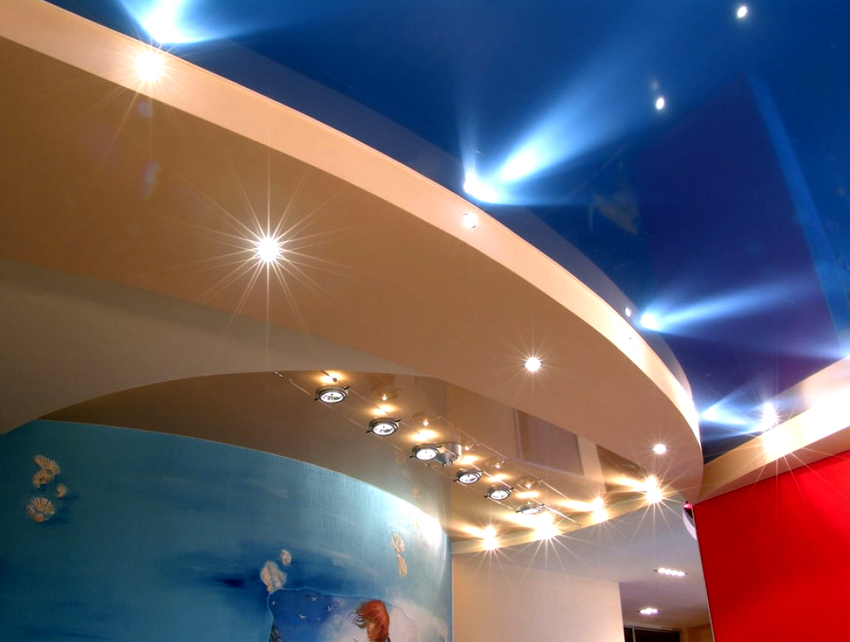
You need to understand that a multi-level design option will take at least 10-15 cm of the room height
- in studio apartments;
- kitchens-dining rooms;
- living rooms combined with other rooms.
A multi-level ceiling will look more attractive if you choose the right lighting system, consisting of a series of spotlights. Attention should also be paid to the execution of joints so that there are no rough transitions from one surface to another. The entire ceiling must form a solid structure. In addition to the fact that high ceilings are required for a multi-tiered structure, attention should be paid to the overall dimensions of the room. In a room with a small area, a massive ceiling will look too heavy and cumbersome, it can visually reduce the size of the room.
How to choose the colors of stretch ceilings, the values of the main shades
Modern manufacturing technologies have endowed the canvases with a variety of colors and shades, which allows the ceiling to complement any interior and room design. In general, all colors can be roughly divided into two groups:
- warm - sunny shades;
- cold - shades of blue, purple and some variants of green.
The main advantage of a cold palette is that with the help of such tones it will be possible to visually expand the boundaries of the room, make it higher and wider. Designers recommend using warm shades in rooms with insufficient daylight, although in brightly lit rooms they will look fun and perky. Bright colors can quickly get bored, so in living rooms it is recommended to avoid too saturated colors, but in hallways, bathrooms or kitchens, it is appropriate to perform a colorful ceiling option.
Helpful advice! As the photos of stretch ceilings demonstrate, colors and shades make rooms look different. So, black, white, purple and blue ceilings make the room visually larger. Red, yellow, orange tones fill the room with warmth and comfort. Light gray, silver and metallic color enhance the sophisticated design ambiance.
By and large, the ceiling can be made in any shade you like, but most often the following options are chosen:
- White. A versatile solution that can be used in any room. However, due to the increased soiling, such ceilings should not be installed where there is a high probability of staining.
- The black. A popular color for creating modern non-trivial interiors, especially in a glossy finish. You should not only combine black ceilings with dark walls, even when creating a Gothic interior.
- Beige, cream, baked milk color. Classic and versatile options that are appropriate for any room.
- Blue. Used to simulate the creation of the firmament. It is most beneficial to emphasize such surfaces with diode strips, which create the effect of a floating canvas.
- Violet. The color of Mediterranean interiors, used in rooms for any purpose.Looks especially beautiful in multi-level structures in combination with white drywall.
- Green. The color of a cheerful mood. Due to the large number of shades, green is used in children's rooms, in bedrooms and in kitchens, a variety of tones allow you to choose the right option for any interior.
- Pink. The main thing is not to choose a color that is too saturated, although if it is successfully combined with the walls, you get an attractive room.
- Yellow orange. Colors fill any room with extra light as well as good mood and cheerfulness. You should not fill the room with a large number of bright accessories with orange ceilings, so as not to get a lurid room.
Stretch ceilings have rightfully earned the love of the consumer, because they differ not only in beauty and a huge selection of various options, but also in quick, dust-free installation. The large number of materials helps to create a one-of-a-kind surface, without the need for any complicated preparatory work. Various shades, patterns, textures, photo printing - all this makes it possible to show design imagination and make the room cozy.
